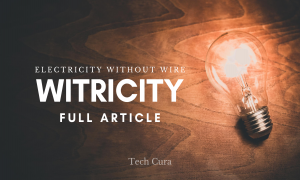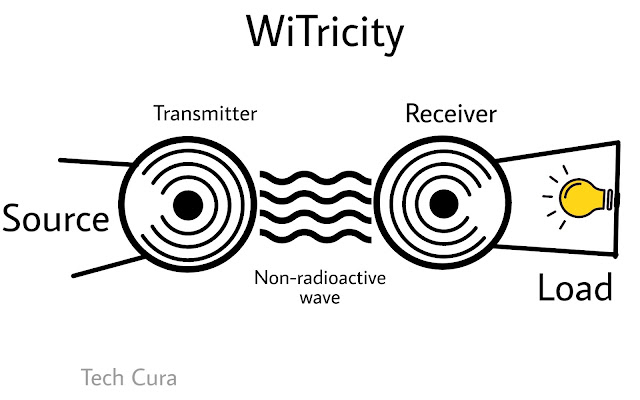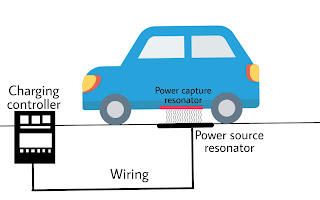WiTricity (Wireless Energy Transfer)
What is WiTricity?
WiTricity is a non-radioactive energy transfer over a distance
without any wire. MIT researcher Marin Soljacic describes the ability to
provide electricity to a remote object without wire. At first, WiTricity is
explored by Nicola Tesla in 1890 by using his demonstration on resonant
transformers, Tesla coils. But the strong grip on this idea founded in recent
years. WiTricity is now extending its application to medical operations to save the patient’s life, charging electric vehicles at any place. This technology also
works in water. So, today we will know some interesting topics of WiTricity - definition, working principles and all others like advantages, disadvantages, and applications, etc.
‘Resonance’ is the property by which the energy transformed.
This technology frees us from power cords or wires, the first step towards a smart
city. WiTricity technology needs a physical separation between two coils – Power
transmitter coil and Power Receiver coils. Power transmission between these
coils depends upon the strongly coupled resonance between them. The transmitter coil
emits a non-radioactive magnetic field and the receiver coil resonates in that
field. The frequency of the resonating magnetic field at MHz.
Now we will see how it works, application, advantages and
disadvantages of WiTricity.
How does it work?
Today technologies are so advanced that electricity can be
transferred over a distance wirelessly by various methods. These are the classification
of types of energy transfer:
WiTricity is depended on the Resonance Coupling under
No-radioactive energy transfer.
Non-radioactive field transfer: Non-radioactive field
transfer are wireless energy transmission techniques over distance.
Resonance coupling: Resonance coupling energy
transfer works on the principle of a primary coil (Power source coil)
generating a predominantly magnetic field and a secondary coil (Power receiver
coil) resonates in the magnetic field and a current generated in the coil when
both of the coils resonate at the same frequency (or near about the same frequency).
The efficiency depends upon their resonating frequencies.
Example: Due
to an explosion, the glass windows of nearby buildings can be shattered. This
is an example of resonance energy transfer. Here the sound energy converted
into vibrating energy. The glasses have their own natural frequency. When the
frequency of the explosion will match the frequency of the natural frequency of
the glasses, the glasses will vibrate. After a time, the glasses will shatter.
This is how a resonance energy transfer works.
The resonance coupled system consists of a high-frequency
power source which drives power through a transmitting coil. The transmitting
coil sends energy through electromagnetic resonance coupling to the receiver
antenna or coil. A pair of similar winding with the same shape and structure is
present in the transmitter and receiver to achieve the wireless power transfer.
The induced electric field in the receiver coil is generated
by the variation the magnetic field produced by the power transmitter coil. So,
the voltages received by the receiver are depended upon the different distances
and different frequencies. The frequency range of the source can be 0.01MHz to
10MHz.
The LC tank or LC circuit does not resonate by itself. So, the LC circuit must be driven by an AC power supply. The frequency at which equality is occurred and hold for a particular circuit is called resonant frequency.
In order to achieve resonance frequency in the oscillatory
circuit the inductive and capacitive reactance of the resonator coil should be
same.
XL = XC
Where ωL
= 1 ÷ ωC
And ω
= 2πf
Capacitive reactance, XC = 1 ÷ 2πfC
Inductive reactance, XL = 2πfL
The formula:
4π2f2LC = 1
And f = 1 ÷ 2π(LC)1/2
Where
XL = Inductive reactance in Ohm
XC = Capacitive reactance in Ohm
f = Frequency in Hertz
L = Inductance in Henry
C = Capacitance in Farads
Features:
The main feature of the technology is its efficiency. The
efficiency defined as the power usable over a distance by the receiver to the
power input or power supply to the power transmitter coil. In many applications, the efficiency is above 90%.
Efficiency = (power usable over a distance by the receiver) ÷
(The power input or power supply to the power transmitter coil)
The electromagnetic field can be pass through a variety of medium like wood, concrete, plastics, textile, gypsum wallboard.
Advantages:
Eco-friendlier: (a) Eliminate the use of removable batteries
(b) More efficient in charging than a normal battery charger
More reliable: (a) Never run out battery power
(b) Less failure due to less wiring
More convenient: (a) Unaffected by weather, day-night cycle
(b) Reduce the cost of setup
Disadvantages:
· · There will be no power transform if the resonance frequency of both coils does not match.
· If there is a ferromagnetic material near it, then power transformation will be low due to radiation.
Applications:
Being a wireless power transformation technique WiTricity
has a wide range of applications. The power transformation in this technique is
safe and efficient. WiTricity can be used in:
1) Wireless power charging: When in this world everyone demands a wireless technology, WiTricity provide us wireless charging feature in our devices in which no batteries required. The interesting feature is it can charge the device while the device is still in use or at rest. Mobile can be charged in home, office, car and any place automatically.
2) Direct power to stationary devices: Many
stationary devices (like – PC, TV, home theatre, machine tools, keyboard,
printer, mouse, etc.) get direct power from the source through WiTricity.
3)
Medical application: Do you know how a
pacemaker works? Yes, you are right by the principle of resonance power
transfer. WiTricity technique is developed in medical equipment like left
ventricular assist device (LVAD) heart assist pumps, pacemaker, and infusion
pumps. These devices in the human body consume power through the skin or over a
distance greater than the thickness of the skin.
4)
Military application: Because of the
wireless charging the military equipment charged at any time. Nowadays military
equipment like electronics in the helmet, night vision glasses, and radio devices
are charged wirelessly which eliminates the use of power cord and heavy
batteries in the military vest.
Conclusion:
WiTricity is the mid-range non-radioactive energy
transformation technique based on strongly coupled resonance. With respect to
distance, the small device has better performance and efficiency. The power
transformation totally depends upon the resonance coupling between the coils.
Due to its wireless operation, the application is huge.
WiTricity is the future technology to supply power to
consumers. Countries demand it to make a smart city. The team of MIT’s next
target is to get a robotic vacuum or a laptop working, charging the devices
placed anywhere in the room and even the robot vacuum presents on the floor.
If you think anything to be changed then comment here.














13 Comments
It's great to know about such information with fully presented details.
ReplyDeleteGreat staff... It helped me in my exam
ReplyDeleteMy pleasure
DeleteThis is amazing . Thanks a lot
ReplyDeleteThank you
DeleteGood
ReplyDeleteThank you
DeleteGreat
ReplyDeleteGood content
ReplyDeleteThanks alot
DeleteIt is great
ReplyDeleteThank you
DeleteThank you
ReplyDeleteThank you for your feedback